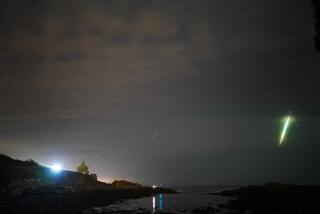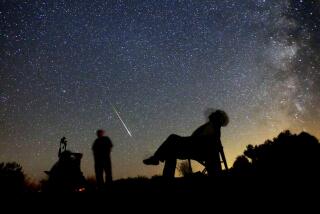Photos Shed Light on Bright Flashes...
- Share via
JUNEAU, Alaska — Scientists at the University of Alaska have finally proved something commercial pilots have known for years:
The atmosphere above thunderstorms can be even more spectacular than the lightning below, with blue and red flashes of light that seem to explode across the night sky.
Pilots have reported seeing bright flashes of colored lights above thunderstorms, but scientists have never been in the right spot at the right time with the right equipment to photograph the lights for further analysis. It was not even certain that the lights really existed, and some atmospheric scientists had theorized that pilots could have been experiencing optical illusions caused by reflection or distortion of the lightning below.
But using equipment developed for the study of the northern lights, scientists at the University of Alaska’s Geophysical Institute in Fairbanks changed all that last year when they captured the first images ever of the dazzling show above the clouds. The photos were released recently.
“They are quite spectacular,” said auroral physicist Gene Wescott, who has devoted a lifetime to studying upper-atmosphere physics. Wescott and his colleagues last year snapped the first color photos ever taken of the mysterious lights, called “sprites,” during flights over electrical storms in the Midwest. This year they photographed the lights over storms in South America.
“The flashes look like the Fourth of July, like Roman candles with fountains,” said Davis Sentman, Wescott’s co-director of the project. The team used a camera developed by the university’s Daniel Osborne that is sensitive to low-light conditions. It has been used primarily for the study of the aurora borealis, and “far exceeded our expectations” over the Midwestern thunderstorms, Sentman said.
Wescott said the most notable lights are bright red, and seem to be produced by an electromagnetic pulse.
“They always seem to be associated with what we call positive strokes,” he said, “which is where a negative charge is being transferred from the ground to the clouds. Normally, it’s the opposite. The negative charge is transferred from the cloud to the ground.”
That tends to happen along the trailing edge of the frontal system, he said. The bright red color is caused by the excitation of the atmosphere’s nitrogen molecules by the enormous energy of the “positive strokes” of lightning, he added.
The red flashes last only a few thousandths of a second, and they extend from the cloud tops up to an altitude of 60 miles. The largest red sprites have what Wescott called “wispy blue tendrils that extend downward through the cloud tops and to the lightning below.”
The red sprites seem to be the most photogenic, but the lights can also be bright blue, and “they are an entirely different animal,” Wescott said.
“The blue jets are the most interesting to me because they appear to have a lot of energy,” he said. The blue jets show up as a high-speed cone of light extending up from the cloud tops. They travel at about 60 miles per second, he said.
More to Read
Sign up for Essential California
The most important California stories and recommendations in your inbox every morning.
You may occasionally receive promotional content from the Los Angeles Times.










